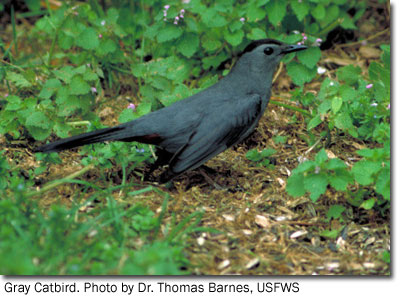Gray Catbird
Dumetella carolinensis
 Description & Range:
Description & Range:
The Gray Catbird is a medium size song bird 8 to 9 inches in length. This bird
is mostly slate gray in color with a distinctive black cap and black tail. The
underside of the tail tends to have some slight chestnut-coloring. Both males
and females are identical in appearance.
Catbirds are usually found in Maryland from April to late October. After
October, many Maryland catbirds migrate to the southern U.S. and some as far as
Panama (unlike the Mockingbird which is found throughout the year in Maryland).
Catbirds occupy much of the eastern and central United States throughout the
summer months.
Habitat:
The Gray Catbird prefers tangled vegetation and dense shrubbery, especially in
moist areas. These birds can be commonly found in urban and suburban
environments that have ample shrub cover.
Diet:
In the summer, catbirds feed mainly on insects such as ants, beetles,
caterpillars, grasshoppers, bugs and spiders. This bird feeds on them from
shrubs or saplings rarely from the ground.
Catbirds probably eat more fleshy fruits than any of the other songbirds. Most
fruit feeding is done within 10 feet from the ground. Preferred fruits are
blackberry, cherry, Holly, Bayberry, Greenbrier, Elderberry, Grape, blueberry,
Pokeweed, Serviceberry, Virginia creeper, Dogwood, Hackberry, Sassafras and
Spicebush.
Reproduction:
Females take on the responsibility of nest building, while males occasionally
help with supplying the needed construction materials. The cup nests are made
from an assortment of twigs, straw and bark woven and melded together with mud.
Occasionally, trash can be weaved into the nest. The female will then lay 1-6
eggs which take up to 15 days to incubate. After almost two weeks, the young
will fledge. Catbirds can hatch up to 3 broods in a good breeding season.
Sounds:
Catbirds, as their name suggests, produce a catlike mewing, and a "check-check"
noise. Catbirds can also mimic like a Northern Mockingbird, although does not
repeat. Some catbirds may sing for up to 10 minutes.
Behavior:
Catbirds can usually be found hopping through thick vegetation. Often, they are
heard more than they are seen. Catbirds, especially in during nesting season,
can be very territorial. Sometimes, catbirds go as far as to chase other
songbirds like the Eastern Wood-Pewee, Chipping Sparrow and Song Sparrow away
and destroy their nests. Catbirds will even defend their territories in the
winter.
For more information on Gray Catbirds, visit the
Cornell Lab of
Ornithology webpage.